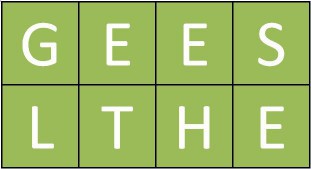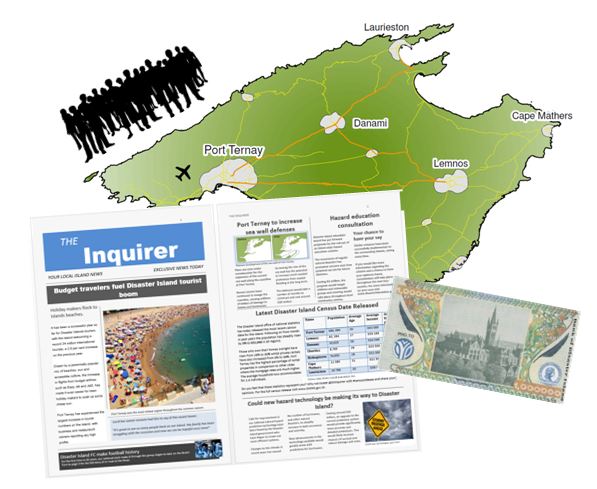Dr Alexandra Gormally, Lancaster Environment Centre, Lancaster University.
One afternoon I was sat trying to think of something useful and engaging to do during an upcoming first year geography tutorial. The tutorial programme itself is designed to support one of our core first year modules ‘Geographical Skills in a Changing World’ and runs alongside a series of lectures and practical workshops, as well as supporting other core modules covering geographical concepts. The tutorial programme has a range of activities that the students engage with throughout the year, such as developing critical thinking, essay writing, presentation skills, debating etc. However, the upcoming slot didn’t have a specific activity assign to it, leaving me to ponder the best course of action. Should I come up with a debating topic? A reading and discussion task linked to a core reference? A speed-revision task (which is popular FYI and I pinched this idea from another tutor – but that’s for discussion on another day)? Being over half way through the academic year the students were tired and bogged down with upcoming deadlines and I began thinking how nice it would be to do something useful that’s also fun and relatively stress free for all involved…
…At this point my brain started to wander and I found myself thinking back to when I was in the first year of my undergraduate degree. At that point, I would never have imagined that I would have a career in academia. I then started to think about all the things that had led me on this path since then, and the things that had inspired and motivated me to get to that point (I was in the 3rd year of my PhD while I was contemplating this). A key turning point for me when was I became interested in the life and work of Gordon Manley. He is a famous British climatologist and also the founder of our weather station and Environmental Science and Geography department (now the Lancaster Environment Centre), here at Lancaster. I won’t go into the details of my Manley ‘crush’ but I became fascinated by his life’s work and through his approach and contribution to our understandings of climate – what a hero! A geographical hero no less! Not only was I inspired but with engagement and learning through his work (and of others), I gained confidence in my own approach and abilities as a researcher. As I was thinking about this I got excited and started discussing and asking my colleagues in the office – who’s your geographical hero?! Suddenly we were all enthusiastically discussing and debating who our heroes were and why. ‘Doreen Massey you say!’ ‘how about Gill Valentine!’ ‘Andrew Sayer!’ ‘Colin Pooley!’ ’Tim O’Riordan!’ There were so many! From academics, to influential and popular commentators, such as David Attenbourgh and Simon Reeve. And as we discussed and debated I was reminded of the work of people that I’d forgotten, or heard about new ones I didn’t know. What an awesome way to spend some procrastination time during the afternoon!
Eventually, I gained focus again on the task at hand – what to do in my upcoming tutorial session. One of the really nice things about running tutorials is that it gives you a chance to get to know the students on a more personal level. I usual start off the year by finding out where they are from, why they chose to study Geography, and why at Lancaster. Often I throw in something cringe-worthy like a fun fact too. It’s always insightful. That’s it – I want to know who their geographical heroes are! A brilliant tutorial task for a sluggish stage in the year. Now, I’m aware that if I’d have been asked that at a similar stage I wouldn’t have had a clue. So I gave a number of pointers or rules:
- Find a geographical hero (if you don’t already have one), someone who’s work or career has inspired you (preferably academic – they can be dead or alive).
- For the next tutorial I want you to:
- Bring a photo/picture of that person
- Tell the group about them and why they inspire you
- Think about their career path
- Discuss how their work relates to your Part 1 geography degree (Talk 5 mins max).
Although initially met with reticence from some students, these tutorials ran remarkably well (I’ve ran this a number of times and has been used by other tutors now too). I think this works for a number of reasons (1) It makes them actively think about what inspires them within geography – and brings back some focus at quite a tiring and draining point in term (2) most students don’t have an obvious ‘hero’ at this point and so reflect on the work of those they have come across so far in the year, and on what they’ve found most interesting (3) they get to learn from each other, sharing perspectives on who and what is of interest across the multi-faceted discipline of geography (4) career wise, it emphasises how many of those ‘heroes’ didn’t necessarily know at the age of 18/19 where their career would take them. Although it’s helpful to have focus and direction, it’s important to stay open to opportunities and not be too hindered by obstacles they may come across in the future.
It would be nice to highlight all the geographical heroes that students discussed but there are too many to name here. Examples include historical figures such as James Croll, Mary Kinsley & Richard Francis Burton, to the more contemporary like Philippe Le Billion and Iain Stewart. Some students even choose academics in our department who have been teaching (and obviously inspiring) them throughout the year. It’s hard to tell whether geographical heroes is something that has stayed with the students throughout their time at Lancaster but I know for me, I am continually inspired by Geography, and the heroes that populate it. This is something that I carry with me during my research and teaching, and I hope others do too.
So anyway, Geographical Heroes – who’s yours?








